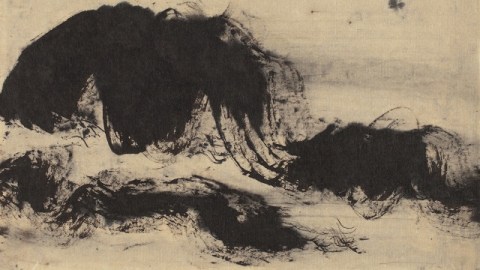Tawara Yūsaku and Your Moment of Zen

For many Americans a “moment of Zen” is the segment that ends every episode of The Daily Show with Jon Stewart. Those brief glimpses of contemporary life usually reprise an earlier bit from the show and are meant to resonate in your head—to literally hum or buzz on some frequency to which words cannot reach in abstract, spiritual sense. A different kind of “moment of Zen” is happening at the Indianapolis Museum of Art with the exhibitionUniverse Is Flux: The Art of Tawara Yūsaku, which runs through April 1, 2012. As the IMA’s curator John Teramoto explains in this video and in catalog to the exhibition, Tawara’s images “seem to float ethereally in their own separate cosmos, and at times they seem to morph or vibrate before our eyes.” What seem to be single strokes are actually countless strokes intricately built up into an image. When you make that realization, Tawara’s art shakes you up and buzzes through what you thought you knew about art. Between Tawara’s fascinating personal story and even more fascinating Eastern perspective on Western art, Universe Is Flux will be “a moment of Zen” that may last you a lifetime.
Tawara won awards for his oil paintings in the 1950s and 1960s and enjoyed a successful one-man show in Tokyo in 1963. Then, suddenly, with no explanation, he stopped painting for the next 30 years. Only after he resumed working did Tawara explain his self-imposed exile from art. When the French artist Balthus toured Japan in that fateful year of 1963, he remarked that Japanese artists should give up oil painting and return to what they’re good at—working in ink. Tawara took those words to heart and gave up his promising career in search of a truer one. For three decades Tawara meditated on art—painting entirely in his head. “More than anything else my perseverance to not create anything became the best prescription for creativity,” Tawara explained in an essay quoted by Teramoto. “It is hard to maintain one’s will and purpose, creating things only in one’s head.”
Slowly, Tawara began to paint small works—from 1 to 5 inches high—in the late 1980s and attach them to cards and letters to friends and business associates. In 1993, however, Tawara returned with a vengeance with larger (albeit still mostly less than 15 inches high) works that make up the bulk of this exhibition. Using either conventional brushes and paper or improvised tools such as bamboo tea whisks and even wrapping paper, Tawara began realizing in the physical world the images he had stored in his head over decades of mediation. “Tawara’s artistic vision and philosophy developed through decades of study,” Teramoto writes, “and his technique was hone through daily intensive practice that was akin to ascetic religious practice. It was both psychologically and physically challenging, involving repetition of the same motif hundreds of times.” At the time of his death in 2004, Tawara left behind more than 3,000 finished paintings collected in folios and albums, having never once offered any of them for sale. The sheer commitment and integrity of Tawara seems almost superhuman, yet the small scale of his works maintains the intimacy of the simply human.
Tawara sought the infinite in his works, believing that if you can see eternity in a single moment, you can find Nirvana in a fragmentary glimpse of the infinite, which his tiny works hoped to offer. Once Tawara began infusing those waves of energy—the hado of Zen philosophy—into his art, he began to recognize the same phenomenon in the art of other masters of the West. Those waves of energy fill the universe and make it flow in an eternal state of flux, hence the title of the show. Since that energy is everywhere in the universe, Tawara naturally found it in the art of Monet, Cezanne, and others.
It was Leonardo da Vinci, however, that stood out to Tawara as the greatest Western Zen master of the energy flux. When Tawara first looked closely at some of Leonardo’s drawings, he was floored by their chaotic energy. “I wondered what it would be like to into da Vinci’s ki (hado) with my body,” Tawara wrote. “In my arrogance, I was truly humbled. Da Vinci is close to being divine.” In an essay on Tawara’s interaction with da Vinci, David Rosand argues that “[w]hat Tawara must have seen in Leonardo’s drawings was a dynamic world in motion, spaces filled with the kind of tension he himself had been celebrating, albeit from a Buddhist perspective.” When Tawara painted Koga wo omoute (Thinking of Old Masters) 7 (shown above), da Vinci was the Old Master he was thinking of primarily, bridging the perceived gap between West and East, between Christianity and Buddhism, between the past and now. Seeing the great works of the Western canon through Tawara’s hado-tinted lens (imagine Jackson Pollock’s drip paintings, for example) brings a whole new energy to the discussion and repositions Asian art as a significant analogue, if not an influence.
In the liner notes to what may be the greatest jazz album of all time, Kind of Blue, pianist Bill Evans wrote in 1959 of Japanese ink painting that for “those [artists] who see well,” they “find something captured that escapes explanation.” Those great, verbally inexplicable images aspire and attain the condition of great jazz music. Universe Is Flux: The Art of Tawara Yūsaku allows the great jazz symphony of Tawara’s art of meditation and laser-like focus to play on a larger stage and reach the “ears” and eyes. The exhibition and catalog admirably introduce and attempt to explain the magical energy Tawara’s art contains and expresses. “I cannot judge the depth of Tawara’s understanding of Buddhism,” Teramoto confesses finally, “but it is very interesting to see how its tenets found expression in his art.” In the end, after we look at Tawara’s art, we must follow his example and give ourselves the gift of time to think.
[Image:Tawara Yūsaku, Japanese (1932-2004), Koga wo omoute (Thinking of Old Masters) 7, 1997, ink on paper, 6 3/8 x 9 1/2 in. (image). Loan from Mrs. Kayoko Okada.]
[Many thanks to the University of Washington Press for providing me with a review copy of the catalog to and to the Indianapolis Museum of Art for the image above and other press materials related to the exhibitionUniverse Is Flux: The Art of Tawara Yūsaku, which runs through April 1, 2012. You can see the IMA’s curator John Teramoto talk about Tawara Yūsaku and this exhibition here.]





